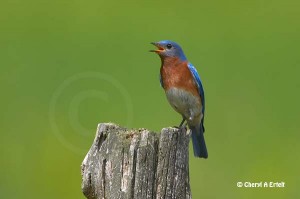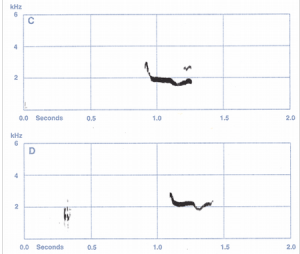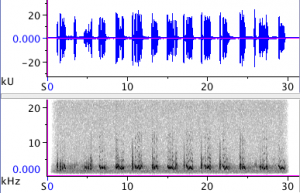The Eastern bluebird is most commonly known for its unmistakable, vibrant coloration. However, the bluebird’s brilliant plumage is certainly not its only unique feature; its frequently overlooked capacity for vocalization is perhaps even more remarkable.
Ertelt, C.A. Eastern Bluebird Singing. Retrieved December 3, 2014 from http://www.photosphrases.com/cpg/displayimage.php?album=312&pos=9
Calls:
The simplest type of Eastern bluebird vocalization is its call. The typical call has been described as a three-syllable “tu-a-wee” phrase, delivered loudly and abruptly (Kroodsma 2005). Calls are used year-round by both sexes, though there is a slight male-female difference in the length and pitch of the calls, as the male vocalization is slightly longer and lower-pitched (Gowaty & Plissner 1998). Calls are generally used for communication between parents and offspring, coordination of foraging during non-breeding seasons, and to signal location to nearby family members (Gowaty & Plissner 1998). Thus, calls help members of the same families communicate and coordinate behavior.
Male call (top), female call (bottom)
Recorded by Sylvia Halkin and PAG, Oglethorpe Co., GA 9, 18 Jul 1993. Sonograms prepared by staff of Borror Laboratory of Bioacoustics, Ohio State University, using a Kay Elemetrics DSP 5500 Sona-Graph. Retrieved from Birds of North America Online on November 28, 2014
Song:
The Eastern bluebird song is a much more complex vocalization that consists of a series of short, often times slurred, 1-3 note phrases that follow each other in extremely rapid succession. Although songs generally follow this basic pattern, there is a great deal of variety among them; unpaired males, which typically sing the most frequently, sing up to 20 types of song per minute (Kroodsma 2005). In a 2002 study, Huntsman and Ritchison observed the singing habits of five Eastern bluebirds during breeding season, when song is most common, and found that song can either be loud or soft. Soft song, which accounted for roughly 60% of the songs observed, is used for short-distance communication to nearby mates and offspring. Loud song, which is somewhat less frequent, is used for long-distance communication (Huntsman and Ritchison 2002). Unlike their male counterparts, female Eastern bluebirds do not typically sing. However, the results of a study performed by Morton et al. (1978) suggest that females demonstrate song capabilities in stressful situations, such as when a predator is present, or when the male is absent from the territory.
Recorded by Donald Kroodsma. Sonogram made using Ravenlight software.
Song has a wide variety of functions in the Eastern bluebird. When males sing, their vocalizations can have an intersexual function, meaning that they allow them to communicate and coordinate behaviors with females. For instance, song functions in attracting potential mates, which is exemplified by the fact that unpaired males reduce the volume, variety, and frequency of their song significantly after finding a mate (Huntsman and Ritchison 2002). Song also allows males to coordinate feeding behaviors within the nest once the offspring have hatched (Huntsman and Ritchison 2002). Additionally, song can have an intrasexual function, meaning that it allows males to send messages to other members of the same sex. The study confirmed that such functions include territory defense and distress communication in the presence of a predator.
Song Acquisition:
Although ornithologists recognize that much more research is necessary to determine the nature of song acquisition in Eastern bluebirds, most agree that calls are innate vocalizations. A 2012 study by Kight et al. showed that begging calls occurred in very young hatchlings, and that they increased slightly in complexity as the birds reached adulthood. The calls seem to be fully developed by the time the birds reach two months of age (Gowaty & Plissner 1998). Despite a major lack of research pertaining to song learning in Eastern bluebirds, many ornithologists believe that song is learned. While observing the Eastern Bluebird, ornithologist Don Kroodsma hypothesized that, because of their large repertoires, it is difficult to pinpoint the influence of parents, neighbors, and other species on song learning in young birds, but that some combination of the three models may be influential.
Song Dialects:
The nature of the Eastern bluebird’s song renders the observation of different dialects extremely challenging. The birds have notably large repertoires; Huntsman and Ritchison (2002) found a range of 40-81 song types among the five birds they studied, and believed that the range would have been much wider if they had they used a larger sample size. There is also great individual difference between birds; in fact, the results of the same study showed that only 6 of 306 song types were shared among 2 or more males (Huntsman & Ritchison 2002). Thus, researchers currently have little direct evidence that suggests the existence of song dialects in the Eastern bluebird.
Despite the lack of direct evidence, there is an extensive body of indirect evidence that suggests the development of different song dialects. A 2012 study by Swaddle et al. shows that the environment has an effect on acoustic signaling. The researchers monitored the behaviors and vocalizations of Eastern bluebird parents and offspring in a variety of different environments. Their results showed that aspects of climate – such as temperature, humidity, and air turbulence – as well as structural features of the environment – such as vegetation and bodies of water – could affect the propagation of sound waves. Thus, in some environments, the begging calls of hatchlings or the calls of parents were drowned out by ambient noise, and parent-offspring communication was thus disrupted (Swaddle 2012). Although much more research is still necessary, the results of this study suggest different environments may select for different, that would be best propagated in that environment. This could lead to the development of different dialects over time. Additionally, in 2013 study performed by Avery et al., researchers compared mainland populations of Eastern bluebird to island populations located in Bermuda. They compared the frequencies of alleles for certain phenotypic traits, such as plumage coloration, and used the Hardy Weinberg equation to determine that the populations were in fact diverging. Although there is still much more research to be done, it is possible that the divergence may eventually lead to the development of different dialects between mainland birds and island birds.
References
Avery, J.D., Fonseca, D.M., Campagne, P., Lockwood, J.L. 2013. Cryptic introductions and the interpretation of island biodiversity. Molecular Ecology 22: 2313-2324.
Gowaty, P.A. and Plissner, J.H. 1998. Eastern bluebird (Sialia sialis), The Birds of North America Online (A. Poole, Ed.). Ithaca, NY: Cornell Lab of Ornithology. Retrieved from http://bna.birds.cornell.edu.libproxy.vassar.edu/bna/species/381
Huntsman, B.O. and Ritchison, G. 2002. Use and possible functions of large song repertoires by male eastern bluebirds. Journal of Field Ornithology 4: 372-378.
Kight, C.R., Saha, M.S., and Swaddle, J.P. 2012. Anthropogenic noise is associated with reductions in the productivity of breeding eastern bluebirds (Sialia sialis). Ecological Applications 22: 1989-1996.
Kroodsma, D. 2005. The Singing Life of Birds. New York, NY: Houghton Mifflin.
Morton, E. S., Geitgey, M.S., and McGrath, S. 1978. On bluebird responses to apparent female adultery. American Naturalist 112: 968-971.
Swaddle, J.P., Kight, C.R., Perera, S., Davila-Reyes, E., and Sikora, S. 2012. Constraints on acoustic signaling among birds breeding in secondary cavities: The effects of weather, cavity material, and noise on sound propagation. Ornithological Monographs 73: 63-77.




when i went to the forest, i see the birds mocking. I think it wasn’t mock, it’s song 🙂